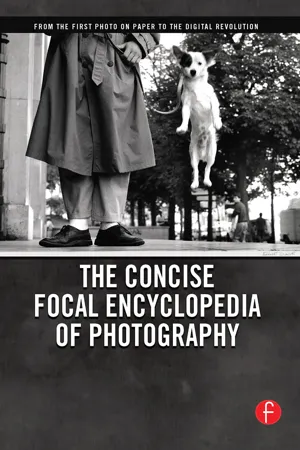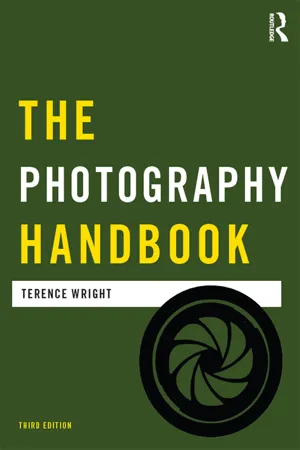History
American Photography
American photography encompasses a rich and diverse tradition that has evolved over time. From the early documentary work of photographers like Dorothea Lange and Walker Evans to the innovative experimentation of contemporary artists, American photography has played a significant role in shaping visual culture. It has captured pivotal moments in history, reflected societal changes, and pushed the boundaries of artistic expression.
Written by Perlego with AI-assistance
Related key terms
8 Key excerpts on "American Photography"
- eBook - ePub
Photography
A Critical Introduction
- Liz Wells, Liz Wells(Authors)
- 2021(Publication Date)
- Routledge(Publisher)
The credit for discovering practical chemical processes lies with no single person, nor, indeed, with any particular nation, although the ascription of credit has always had nationalistic overtones with, for example, the French, keen to downgrade British claims (1839 was within a generation of the Battle of Trafalgar). Likewise, strenuous rewritings of history allowed the German photohistorian, Stenger, writing in the 1930s during the ascendance of Hitler, to claim German experiments of the eighteenth century as fundamental for photography. Re-examining the prehistory, Mary Warner Marien urges caution in two respects: first, she warns against too uncritical an acceptance of the work of early photohistorians. She notes the extent to which the burgeoning of research in the field since the Second World War has both uncovered new findings and suggested new ways of thinking about previously known facts within the history of photography; recent research represents only the beginning of a much-needed archaeology of early photography. In addition, she emphasises the broader historical context of political, technological and cultural change within which photography developed. The overall point is that, in considering the origins of photography, a stance which is both cautious and critical should be adopted (Warner Marien 1991). Geoffrey Batchen offers a more detailed discussion which points to the complexities involved in reappraising early photography in terms of who founded it, where and for what purposes (Batchen 1997).The photograph as image
While earlier writing on photography had not exclusively focused on technology and techniques, since the Second World War art-historical concerns have become more central, together with a new stress on connoisseurship of the photograph as a privileged object analogous to a painting. A number of the books which we now take as key texts on the history of photography were first written as exhibition catalogues for works collected and shown in institutions. For instance, Beaumont Newhall’s The History of Photography - eBook - ePub
- Tanya Sheehan, Andres Zervigon(Authors)
- 2014(Publication Date)
- Routledge(Publisher)
As Régis Durand wrote in 1989, loosely quoting Lewis Baltz, “even though Americans did not invent photography they should have.” 24 As W. J. T. Mitchell put it, even the phrase “American Photography” has today the same “ring of inevitability” as “French painting” or “Greek sculpture,” so that we may think of it as “a ‘naturalized’ and ‘nationalized’ immigrant European medium.” 25 To a viewpoint not centered on the US, this popular consensus appears linked to the growing dominance, in the twentieth century, of US industries, institutions, publishers, museums, and markets in the production, trade, preservation, and discussion of photographs. Still, just as there is no escaping the European origins of photography, there is little room to escape what Durand called its “peculiar affinity” with American culture, or, in Jonathan Green’s terms, the “American experience.” 26 Here lies the first of what I would call the “foundational contradictions” of photography’s historiography: European in (scientific) origin, American by (practical and cultural) development. This is perhaps banal, if we remember the older consensus that sets Europe, in the nineteenth century, as the parent continent of science, and North America (ahead of other “younger” societies) as a fertile field for application, improvement, and productivity. As Alexis de Tocqueville put it, In America the purely practical part of science is admirably understood, and careful attention is paid to the theoretical portion which is immediately requisite to application. On this head the Americans always display a clear, free, original, and inventive power of mind - eBook - ePub
Rethinking Photography
Histories, Theories and Education
- Peter Smith, Carolyn Lefley(Authors)
- 2015(Publication Date)
- Routledge(Publisher)
This was a departure from the earlier leftist (European and American) model of artistic modernism that aligned artistic progress with wider social advancement. The camera had been seen in this context as a rational device that could be used for extending human perception. The militant avant-garde in the 1920s and 1930s had social aims that extended beyond the academy. Although art photography did not directly contravene these ideals the change in sensibility from an investigative, documentary and socially responsive outlook to the reflective and depoliticized styles by the end of the 1940s is historically significant. This description defines the Cold War attitudes in America but there are equivalent trends in other parts of the West in this period.The American brand of formalism we have described is centred on the idea that photography is an autonomous medium with a paradoxical claim to the status of art. Although the experience of art is heightened by the alienating culture that surrounds it, photography (for the formalist) is valued for its own sake. For the postmodernist, who is opposed to the American brand of formalism described above, photography belongs to every discipline and every institution. It is inescapably part of everything and its meanings are constantly shifting. In this view photographs have a productive (social) as well as an aesthetic value.Thinking in a similar vein, Batchen says photography is a ‘misleading fiction’ (1999: 176) and has no identity of its own since it is widely dispersed in culture in general. The two views (formalist/anti-formalist) are diametrically opposed and yet, as Batchen has noted ‘they share some common approaches on the crucial question of photography’s identity’.Both for example equate the origins of that identity with the unfolding of history (social history on the one hand, and art history on the other). More importantly, both presume that photography’s identity can indeed be delimited, that photography is ultimately secured within the boundaries of either nature or - eBook - ePub
- Michael R. Peres(Author)
- 2013(Publication Date)
- Routledge(Publisher)
It would be hard to imagine a technology that had more impact on 20th century life than photography: the automobile, the airplane, nuclear power, all of these were higher profile than photography, yet in day-to-day terms, photography was truly the most pervasive. Here the effect that photography has had on 20th century society will be discussed in four distinct areas: amateur photography (making everyone a photographer), advertising photography (creating desire in the public), journalistic/editorial photography (informing and entertaining the public), and documentary photography (recording the lives of real groups of people).Background
To imagine a social world before photography, we would have to think of a world without picture IDs; without portraits of ordinary people (or schoolchildren); one without pictures as souvenirs of travel; one without celebrity pictures; one without advertising photographs; one without X-rays or views of outer space; a world without views of foreign and exotic peoples; one without pictures of sports, wars, and disasters; and one in which the great masses of people had no way to visually document the important events of their lives.Such a world is unimaginable to us now, and we have photography to thank for all these things: visual souvenirs, portraits of common folk as well as the famous, advertising pictures that have created desire in the public and educated them about all the products the new consumer culture has on offer, medical diagnostic tools, incredible views of exotic places and even of outer space, pictures of the world’s news, and most important, pictures of the events and intimate moments of one’s own life.The technology of photography is part chemical, part optical, and dates from 1839. Soon after its simultaneous invention by William Henry Fox Talbot in England and Louis Jacques Mandé Daguerre in France, photography was used to document foreign places of interest such as India, the Holy Land, and the American West. It was also used for portraits with photographs taken of kings, statesman, and theater or literary personalities.During the 19th century, however, cameras were mainly in the hands of professionals or self-educated entrepreneurs who tried photography as a trade. Interestingly, photography has never required professional licensing or guild membership (with the exception of Talbot’s unsuccessful attempt to sell licenses early after his invention). In the mainstream, any tinker or businessman could buy the equipment, obtain the directions, and proceed. This openness of the medium made photographic practice rather free from the traditions that had grown up around painting or the various printmaking arts. - eBook - ePub
Photography
The Key Concepts
- David Bate(Author)
- 2020(Publication Date)
- Routledge(Publisher)
This brings us back to the point made at the beginning of this chapter, and the proposition by Freud that the invention of photography empowers the faculty of recollection. What is the impact of this photographic power of recollection? With the constant production and reproduction of billions of photographs on a daily basis, the problem for any historical work on photography today is to find a method that can cope with such quantity. One solution has been to start with the idea of personal memory, since most people have private archives of photographs, if only snapshots of family, friends, and so on. These specific private histories and the social memories derived from them certainly contribute to a new realm of personal histories (or, as some feminists argue, herstories too) and give access to a dimension of the social world that was rarely represented hitherto. In the hands of some, these personal and biographic histories have become a way of doing social history (a good example is the writings of W. G. Sebald). In the hands of others, personal history may also be a means to evacuate a story from any social or general history altogether.If the purpose of using photographs in history is to “see” the past, then it is nevertheless important to remember that the photograph is always already a mediated view, an interpretation whose meaning is potentially polysemic, thoroughly plural in potential meaning. This is the uncomfortable fact about any photograph or document in historical work; a photographic meaning is not fixed in history, it is the historian who does that: meaning is fixed by the discourse of history—an uneasy alliance between the image and the historian alongside all the other documents they have at hand.Chapter Summary- History is a narrated representation of events.
- The account of historical events given will depend on the viewpoint of the historian.
- The history of photography has typically been a general history or, specific histories neglected by that general history.
- The historical collection of photography within art museums has tended to emphasize photography as an aesthetic form, selecting the “best of the best,” which ignores that photography exists across a plurality of social sites and institutions.
- Photography creates images for history, but reading these involves making interpretations of complex facts.
- eBook - ePub
- Amy Mccoll(Author)
- 2005(Publication Date)
- Routledge(Publisher)
Who Built America? is both a two-volume textbook and an interactive compact disc, the result of a project that began in 1982 under the leadership of historian Herbert Gutman whose goal was to brook the gap between developments in social history research and writing in academia and what the public was getting in popular history. The American Social History Project has as its goal to produce a range of educational products covering U.S. history from 1607 to the end of World War I for students and educators. The textbook and CD-ROM are noteworthy for the weight given to images. Yet while the project staff were clearly committed to producing a visually-oriented body of education material, they remained uneasy about images and their effect on the viewer.The visual record of the past—particularly regarding the lives of working men and women, immigrants, and people of color— requires careful consideration…Pictures that were produced and viewed in specific historical eras can teach us a lot about working peoples’ lives, but it is equally important to understand there is much that these pictures obscure or fail to show.42The compact disc version of Who Built America? was produced by the Voyager Company (Santa Monica, CA) in 1993 and is accompanied by a 20 page users guide.ANTHROPOLOGY
In anthropological field work the camera has become an essential tool, and the literature on visual anthropology is extensive. A highly selective list of the major writings that would be of particular pertinence to historians includes the following:John Collier Jr. and Malcolm Collier, Visual Anthropology: Photography as a Research Method (Albuquerque: University of New Mexico Press, 1986).Sol Worth, Studying Visual Communication (Philadelphia: University of Pennsylvania Press, 1981).Melissa Banta and Curtis Hinsley, From Site to Sight: Anthropology, Photogra phy and the Power of Imagery (Cambridge: Peabody Museum Press, 1986).Anthropology and Photography, 1860–1920, edited by Elizabeth Edwards (New Haven: Yale University Press, 1992)Joanna Cohan Scherer, “Historical Photographs as Anthropological Documents: A Retrospect,” Visual Anthropology - eBook - ePub
The Concise Focal Encyclopedia of Photography
From the First Photo on Paper to the Digital Revolution
- Michael R. Peres(Author)
- 2014(Publication Date)
- Routledge(Publisher)
The photography industry subsequently grew. More people became enabled to make more photographs. Cameras were freed from the tripod. Color and motion picture photography became possible. The applications of photography steadily multiplied and increasingly benefited society. “Masters” of the medium, in every era, created photographs that transformed how we see and what we know. The developments of the last decade now make it necessary to deconstruct and reassemble that history of photography to include the origins, progress, and transformation of electronic imaging as well as that of other recording, reproduction, and information technologies. For instance, Becquerel’s observation of the photovoltaic efiect in 1839 must be placed along with Daguerre and Talbot’s discovery of principle of the latent image as a primal moment in the history of photography. Every purchase of a digital camera adds to the historical importance of the discovery of the conversion of light into electricity. With the convergence of imaging and information technology, it is now quite legitimate to trace the history of photography within many contexts other than that of the progress of optics and chemistry. Photography is now seen as a part, not the all, of imaging technology. The very definitions of photography and photograph are in transition along with the technology and industry of photography. Thus the history of photography must also change as silver is replaced by silicon. A new generation of photographers will soon know nothing directly of the thrill and mystery of the development of the latent image, which has long been the initiatory experience and bond among serious photographers. The digital revolution, like all revolutions, is in the process of disrupting and destroying an old order - eBook - ePub
- Terence Wright(Author)
- 2016(Publication Date)
- Routledge(Publisher)
But Berkeley’s dilemma between appearance and reality remains not only as a key issue in media reporting, but also as a central concern to the principles of photography. In the case of digital photography this is not quite so significant as the medium does not rely on the presence of an inverted image physically captured on the film.At the time of its invention, photography was thought to realise the representational goals of Western art, just as Victorian culture was thought to be the acme of refinement, having developed from the ‘primitive’ social organisation of ‘savages’.Charles Darwin sums up the theory of culture that prevailed during the year that the invention of photography was announced: ‘One’s mind hurries back over past centuries, and then asks, could our progenitors be men like these? – men, whose very signs and expressions are less intelligible to us than those of domesticated animals’ (Darwin 1839 : 474).The developmental approach to the history of art, which was characteristic of nineteenth-century theories of cultural evolution, saw the developing trends towards realism as constituting art’s evolution. It echoed the late Victorian theories of culture.In this view, the early stirrings of primitive art could be seen as formative efforts in attempting to represent a world of confusion and magic.4 In the late nineteenth century, this was equated with the drawings of children. With the rise of civilisation, the Greeks and Romans began to develop more or less correct means of picturing, employing depth cues and early forms of perspective. As Western culture descended into the dark ages, so visual representation degenerated, only to be rediscovered and reach new heights during the Renaissance, when perspective proper was developed. Finally, in the nineteenth century, photography was invented which, in accord with the contemporary views of cultural ascent,5 provided the mechanical means of faithful representation. This view of cultural ascendancy does have contemporary significance in serving to demonstrate how camera representation became so deeply rooted in the social values of Western culture. For example, we might consider it is important to recognise the philosophical determinants of this particular sort of nineteenth-century representation, again marking an age when a considerable degree of faith was placed in current technology. A stereoscopic image produced by photographer and scientist Antoine François Jean Claudet not only features a number of his own inventions, but has resulted in a study that takes pride in the technological advancements of his era (see Figure 1.5
Learn about this page
Index pages curate the most relevant extracts from our library of academic textbooks. They’ve been created using an in-house natural language model (NLM), each adding context and meaning to key research topics.







